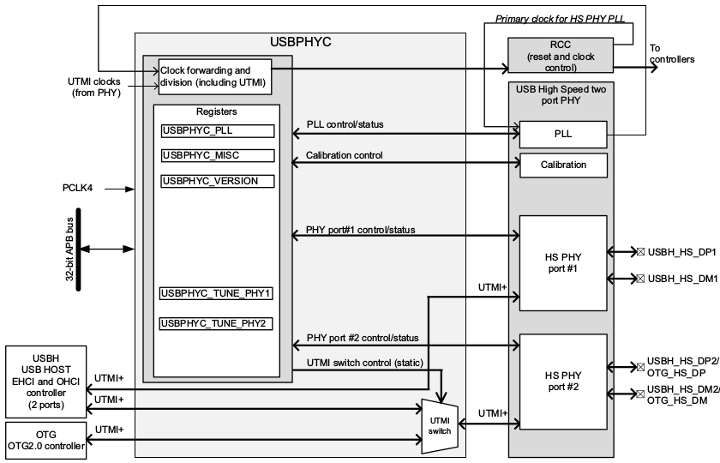1 Article purpose[edit source]
The purpose of this article is to
- briefly introduce the USBPHYC peripheral and its main features
- indicate the level of security supported by this hardware block
- explain how each instance can be allocated to the three runtime contexts and linked to the corresponding software components
- explain, when necessary, how to configure the USBPHYC peripheral.
2 Peripheral overview[edit source]
The USBPHYC peripheral is a block that contains a dual port USB high-speed UTMI+ PHY and a UTMI switch. It makes the interface between:
2.1 Features[edit source]
The USBPHYC peripheral:
- controls a two port high-speed PHY:
- sets the PLL values
- performs other controls (and monitoring) on the PHY.

Refer to STM32MP15 reference manuals for the complete list of features, and to the software components, introduced below, to see which features are implemented.
2.2 Security support[edit source]
The USBPHYC is a non-secure peripheral.
3 Peripheral usage and associated software[edit source]
3.1 Boot time[edit source]
USBPHYC instances are boot devices that support Flash programming with STM32CubeProgrammer.
The USBPHYC peripheral is used by ROM code, FSBL and SSBL when using OTG in Device mode (DFU).
The SSBL can use OTG in Host mode or USBH (mass storage). The USBPHYC peripheral can be used to boot on a kernel stored on a USB key, or after a kernel panic to perform the crash dump saving to the USB key.
3.2 Runtime[edit source]
3.2.1 Overview[edit source]
The USBPHYC peripheral can be allocated to the the Arm® Cortex®-A7 non-secure core to be used under Linux® with PHY framework.
The peripheral assignment chapter describes which peripheral instance can be assigned to which context.
3.2.2 Software frameworks[edit source]
Internal peripherals software table template
| High-speed interface | USBPHYC (USB HS PHY controller) | | Linux PHY framework | | |- |}
3.2.3 Peripheral configuration[edit source]
The configuration is applied by the firmware running in the context to which the peripheral is assigned. The configuration can be done alone via the STM32CubeMX tool for all internal peripherals, and then manually completed (particularly for external peripherals) according to the information given in the corresponding software framework article.
For Linux kernel configuration, please refer to USBPHYC device tree configuration.
3.2.4 Peripheral assignment[edit source]
Internal peripherals assignment table template
| rowspan="1" | High speed interface | rowspan="1" | USBPHYC (USB HS PHY controller) | USBPHYC (USB HS PHY controller) | | ☐ | | |-
|}